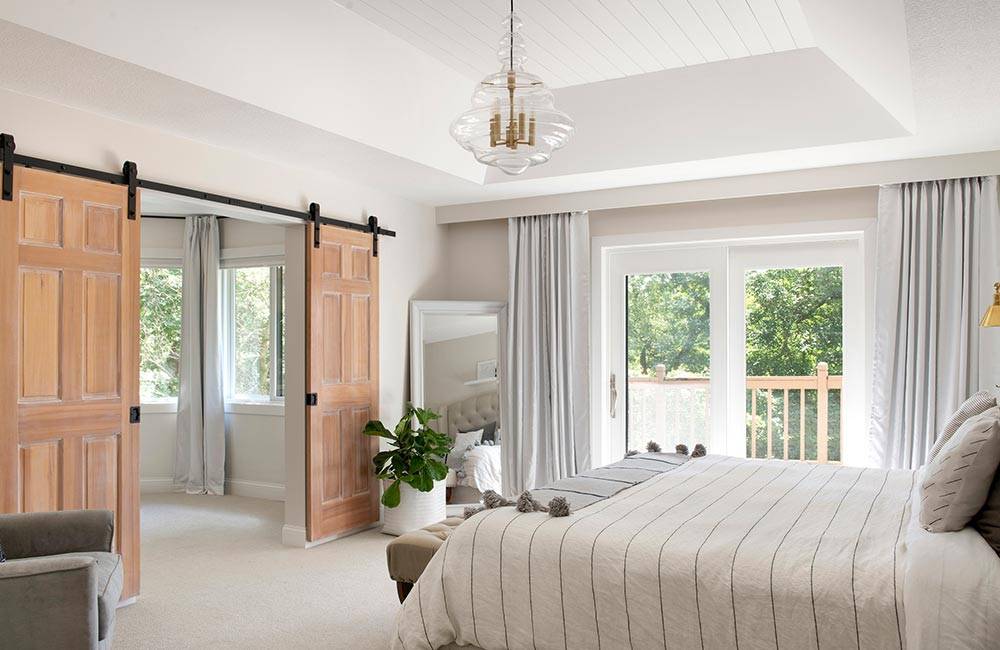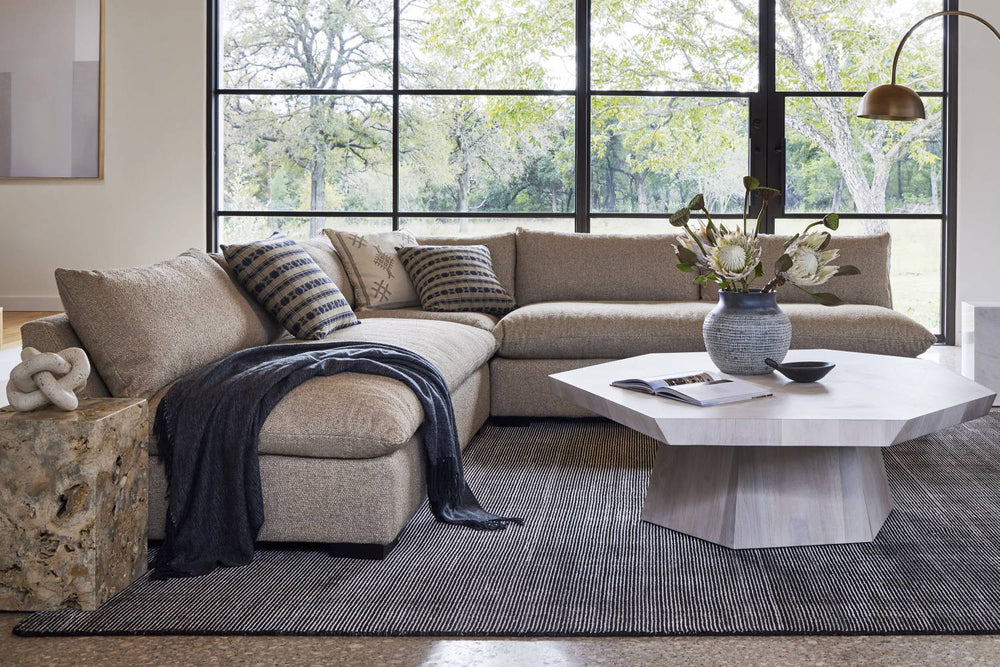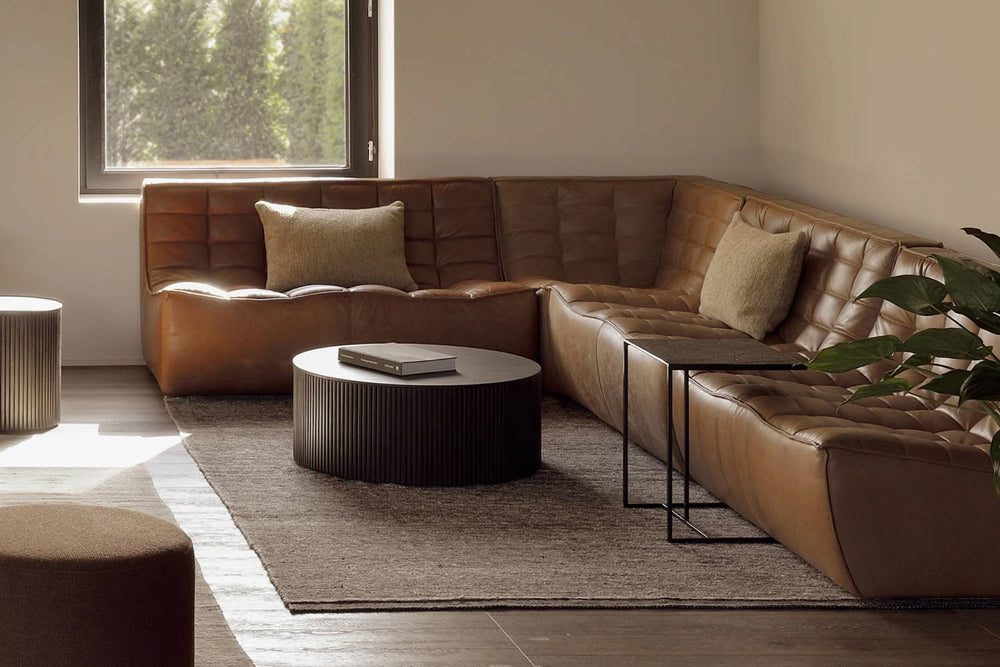Placing a rug in a living room might seem like a straightforward task, but it can significantly influence the overall ambiance and functionality of the space. The right rug can anchor your furniture, define different areas within an open floor plan, and add warmth and texture to the room. Whether you’re looking to make a bold statement with a vibrant pattern or prefer the subtle sophistication of a neutral design, understanding the basics of rug placement is crucial. In this guide, we'll explore essential tips and strategies to help you choose and position your rug perfectly, ensuring your living room looks cohesive and inviting.
Choosing The Right Size Rug
Selecting the appropriate rug size for your living room is essential to achieving a balanced and harmonious space. A rug that is too small can make the room feel disjointed, while one that is too large may overwhelm the space. Here are some guidelines to help you choose the right rug size for your living room:
- Measure Your Space: Begin by measuring your living room and the area where you plan to place the rug. This will give you a clear idea of the dimensions you need to work with.
- Furniture Placement: Consider the arrangement of your furniture. A common rule is to ensure that all the front legs of your seating (sofas, chairs) rest on the rug, which helps to unify the seating area.
- Small Spaces: Ideal for compact living rooms or apartments. This size works well when placed under a coffee table with the front legs of sofas and chairs resting on the rug.
- Centerpiece: Can serve as a focal point in the center of a small room, anchoring a coffee table and leaving some flooring exposed, which can make the room feel more spacious.
- Moderate Coverage: Slightly larger than a 5x8 rug, it offers more coverage and works well in small to medium-sized living rooms.
- Furniture Grouping: Allows for more of the furniture to sit on the rug, creating a more cohesive look. Typically, the front legs of all seating pieces will be on the rug.
- Medium to Large Rooms: This size is a popular choice for medium to large living rooms. It provides ample space for all the main furniture pieces to sit on the rug, including sofas, chairs, and coffee tables.
- Unification: Helps to unify a seating area, making the room feel well-organized and spacious. It’s particularly effective in open-plan spaces to define the living area.
- Large Rooms: Best suited for large living rooms or open floor plans. This size allows all furniture pieces, including larger sofas and armchairs, to sit entirely on the rug.
- Luxury and Comfort: Creates a luxurious feel and adds warmth to the room. It covers a significant portion of the floor, which can make the space feel more intimate and comfortable.
- Expansive Spaces: Perfect for very large living rooms or expansive open-plan areas. This size can cover most of the floor area, creating a grand and unified look.
- Full Room Coverage: Often used when the goal is to cover almost the entire living room floor, leaving just a small border of flooring visible around the edges.
Basic Rug Positioning Guidelines
Proper rug positioning can dramatically enhance the look and feel of your living room. Here are some basic guidelines to help you position your rug effectively:
1. Front Legs On, Back Legs Off
- Guideline: Place the front legs of all major furniture pieces (sofas, chairs) on the rug, while the back legs remain off.
- Effect: This method helps to anchor the furniture arrangement and define the seating area without overwhelming the space.
- Best For: Small to medium-sized living rooms where you want to maintain a sense of openness.
2. All Legs On
- Guideline: Ensure all furniture legs are positioned on the rug.
- Effect: This creates a unified, cohesive look and can make a room feel more substantial and anchored.
- Best For: Larger living rooms or open floor plans, where a larger rug can accommodate all the furniture.
3. No Legs On
- Guideline: Place the rug in the center of the seating area, with no furniture legs on it.
- Effect: The rug acts as a focal point or an accent piece, adding a pop of color or texture without integrating the furniture.
- Best For: Small rugs used as decorative elements or in very small living rooms where placing furniture on the rug isn't practical.
4. Under the Coffee Table
- Guideline: Position the rug so it centers under the coffee table, with the edges extending beyond the table.
- Effect: This draws attention to the coffee table and can help organize a smaller seating arrangement around it.
- Best For: Small to medium-sized rugs in intimate seating areas.
5. Layering Rugs
- Guideline: Layer a smaller rug over a larger one, with the larger rug acting as a base.
- Effect: Adds texture and visual interest, allowing you to combine patterns and colors creatively.
- Best For: Eclectic or bohemian-style living rooms, or when you want to add depth to a neutral base rug.
6. Defining Zones
- Guideline: Use rugs to define different zones within an open floor plan.
- Effect: This creates distinct areas for lounging, dining, or working, making large spaces feel more organized and purposeful.
- Best For: Open-concept living rooms or multi-functional spaces.
Placement Techniques With Specific Furniture
Proper rug placement in a living room can highlight your furniture arrangement, create harmony, and enhance the room's overall aesthetic. Here are some specific techniques for placing rugs with various furniture pieces:
1. Rug with Sofa and Chairs
-
Front Legs On, Back Legs Off: Position the rug so that the front legs of the sofa and chairs are on the rug while the back legs are off.
- Effect: This technique anchors the furniture without overwhelming the space, making it feel cohesive yet open.
- Best For: Small to medium-sized living rooms.
-
All Legs On: Place the rug under all four legs of the sofa and chairs.
- Effect: Creates a unified, spacious look that makes the seating area feel like a distinct zone.
- Best For: Larger living rooms or open floor plans.
2. Rug with Coffee Table
-
Centered Under Coffee Table: Place the rug directly under the coffee table, ensuring it extends beyond the table’s edges.
- Effect: This focuses attention on the coffee table and defines the central seating area.
- Best For: Small to medium-sized rugs and intimate seating areas.
3. Rug with Sectional Sofa
-
L-Shaped Rug Placement: Position the rug so that it extends beneath the sectional, covering the floor under the main seating area.
- Effect: Complements the shape of the sectional and ties the seating area together.
- Best For: Sectional sofas in both small and large living rooms.
-
All Legs On: Place the rug under the entire sectional sofa, including all legs.
- Effect: Creates a cohesive and anchored look, especially in large living spaces.
- Best For: Large living rooms or open floor plans.
4. Rug with Accent Chairs
-
Individual Rugs for Each Chair: Place a small rug under each accent chair.
- Effect: Highlights each chair as a unique element and can add color or texture to the room.
- Best For: Eclectic or bohemian styles, small living rooms.
-
Shared Rug for Accent Chairs: Position a larger rug under a pair or group of accent chairs.
- Effect: Creates a defined seating area or conversation nook.
- Best For: Medium to large living rooms.
5. Rug with Coffee Table and Sofa
-
Rug Under Coffee Table and Front Legs of Sofa: Position the rug so it covers the area under the coffee table and extends to include the front legs of the sofa.
- Effect: Anchors the coffee table and sofa together, creating a unified look.
- Best For: Small to medium-sized living rooms.
Rug Arrangement Tips For Different Room Sizes
Arranging rugs properly can enhance the aesthetic and functionality of any living room, regardless of its size. Here are some tips for rug arrangements tailored to different room sizes:
Small Living Rooms:
Use Smaller Rugs:
- Guideline: Opt for 5x8 feet or 6x9 feet rugs.
- Effect: These sizes work well without overwhelming the space and help define specific areas, like a seating area around a coffee table.
Front Legs On, Back Legs Off:
- Guideline: Position the rug so that only the front legs of the sofa and chairs are on the rug.
- Effect: Creates a unified look while making the room feel more open.
Central Focal Point:
- Guideline: Place a small rug in the center of the room, under a coffee table.
- Effect: This draws attention to the center and helps organize the seating arrangement.
Avoid Wall-to-Wall Coverage
- Guideline: Leave a border of floor space around the edges of the rug.
- Effect: Makes the room feel larger and prevents the rug from overpowering the space.
Medium-Sized Living Rooms:
Opt for Medium Rugs
- Guideline: Choose rugs in the 8x10 feet range.
- Effect: Offers ample coverage to define the seating area without overwhelming the room.
All Front Legs On
- Guideline: Ensure that the front legs of all major furniture pieces rest on the rug.
- Effect: Unifies the seating area and makes the space feel cohesive.
Layering Rugs
- Guideline: Use a large base rug with a smaller, accent rug on top.
- Effect: Adds depth and texture, and allows for creative combinations of colors and patterns.
Balanced Proportions
- Guideline: Center the rug in the room, leaving equal space on all sides.
- Effect: Achieves a balanced, well-proportioned look.
Large Living Rooms:
Go for Larger Rugs
- Guideline: Choose rugs that are 9x12 feet or larger.
- Effect: Provides enough coverage to encompass all furniture, creating a unified and anchored look.
All Legs On
- Guideline: Place all furniture legs on the rug.
- Effect: Creates a grand, cohesive look that makes the room feel more intimate and well-organized.
Define Zones
- Guideline: Use multiple rugs to define different areas, such as seating, dining, and reading nooks.
- Effect: Helps to organize large, open spaces and creates distinct functional areas.
Consider Shape and Orientation
- Guideline: Use rectangular, round, or square rugs depending on the furniture layout.
- Effect: Ensures that the rug complements the room’s shape and furniture arrangement, enhancing the overall design.
Additional Design Tips
-
Color Coordination:
- Match Existing Decor: Choose a rug that complements the color scheme of your living room. If your furniture and walls are neutral, consider a rug with bold colors to add vibrancy. Conversely, if your room already has a lot of color, a neutral or single-tone rug can create balance.
- Create Contrast: Use contrasting colors to make the rug stand out. For example, a dark rug in a light-colored room can create a striking visual effect.
- Harmonize Hues: Pick a rug that includes colors found elsewhere in the room, like in cushions, curtains, or artwork, to tie the space together.
-
Pattern Selection:
- Geometric Patterns: Great for modern and contemporary spaces. They add a structured and dynamic feel to the room.
- Floral or Ornate Patterns: Ideal for traditional or eclectic styles, adding elegance and detail.
- Stripes: Can elongate or widen the appearance of the room depending on their orientation.
- Abstract Designs: Perfect for adding a unique touch to modern or artistic spaces, creating a focal point with their eye-catching designs.
- Scale of Patterns: In small rooms, avoid overly large patterns as they can overwhelm the space. In larger rooms, small patterns may get lost, so consider larger or bolder designs.
-
Texture and Material:
- Natural Fibers: Rugs made from wool, jute, or cotton can add warmth and texture.
- Synthetic Fibers: Durable and often easier to clean, making them suitable for high-traffic areas.
Traffic Flow Considerations:
-
Clear Pathways:
- Unobstructed Movement: Ensure the rug does not impede the natural flow of movement through the room. High-traffic areas should have enough space for people to walk comfortably without stepping off the rug awkwardly.
- Entrance and Exits: Place the rug in a way that leaves clear pathways to doorways and other entry points.
-
Anchoring Furniture:
- Prevent Slipping: Use rug pads to keep the rug in place, preventing it from slipping or bunching up as people walk over it.
- Secure Edges: Make sure the edges of the rug are not curling up, as this can be a tripping hazard.
-
Size and Positioning:
- Hallway or Walkway Areas: If the rug is in a pathway or a hallway within the living room, ensure it is long enough to cover the entire walking area and wide enough to prevent people from stepping off the sides.
- Centralized Placement: For seating areas, position the rug centrally so that it covers the high-use areas where people walk around furniture.
-
Durability and Maintenance:
- High-Traffic Areas: Choose rugs made of durable materials that can withstand heavy foot traffic. Wool and synthetic blends are often good choices for these areas.
- Easy to Clean: Select rugs that are easy to clean, especially if they are placed in areas where spills and dirt are more likely. Consider rugs with patterns that can help hide stains.
-
Additional Tips:
- Layering for Texture: In high-traffic areas, consider layering a smaller, more durable rug over a larger, softer rug. This can protect the larger rug while adding texture and interest.
- Light and Dark Colors: Light-colored rugs can make a room feel larger and more open but may show dirt more easily. Darker rugs can create a cozy, intimate feel and are better at hiding stains and wear.
- Seasonal Changes: Consider changing rugs with the seasons. Lighter, breezier rugs for summer and warmer, cozier options for winter can refresh the room's look and feel.
By considering these aspects of color, pattern, and traffic flow, you can choose and place rugs in a way that enhances both the aesthetic appeal and practicality of your living room.
Mastering the art of rug placement in your living room can transform the space into a cohesive and inviting environment. By considering factors such as rug size, furniture arrangement, and room layout, you can create a harmonious balance that enhances both aesthetics and functionality. Whether your goal is to define separate areas within an open floor plan, add a pop of color, or simply provide a cozy underfoot experience, thoughtful rug placement is key. With these tips and strategies, you can confidently choose and position your rug to elevate your living room's style and comfort.








